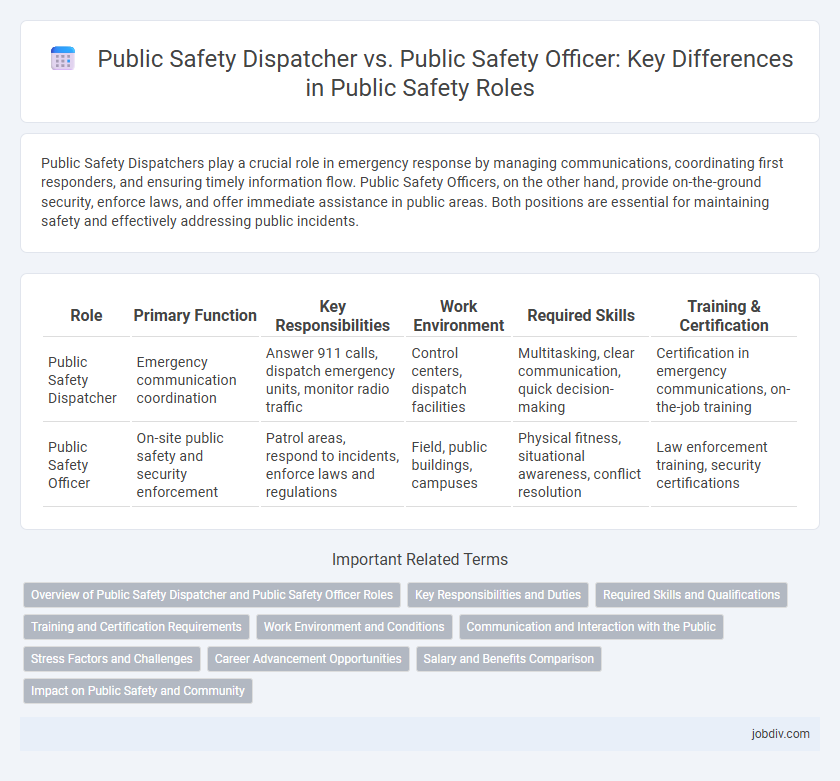Public Safety Dispatchers play a crucial role in emergency response by managing communications, coordinating first responders, and ensuring timely information flow. Public Safety Officers, on the other hand, provide on-the-ground security, enforce laws, and offer immediate assistance in public areas. Both positions are essential for maintaining safety and effectively addressing public incidents.
Table of Comparison
| Role | Primary Function | Key Responsibilities | Work Environment | Required Skills | Training & Certification |
|---|---|---|---|---|---|
| Public Safety Dispatcher | Emergency communication coordination | Answer 911 calls, dispatch emergency units, monitor radio traffic | Control centers, dispatch facilities | Multitasking, clear communication, quick decision-making | Certification in emergency communications, on-the-job training |
| Public Safety Officer | On-site public safety and security enforcement | Patrol areas, respond to incidents, enforce laws and regulations | Field, public buildings, campuses | Physical fitness, situational awareness, conflict resolution | Law enforcement training, security certifications |
Overview of Public Safety Dispatcher and Public Safety Officer Roles
Public Safety Dispatchers coordinate emergency responses by receiving and prioritizing calls, dispatching appropriate personnel, and maintaining communication between responders and the public to ensure timely assistance. Public Safety Officers perform on-the-ground duties such as patrolling, enforcing laws, providing first aid, and responding directly to incidents to maintain community safety. Both roles are critical in the emergency response system, with dispatchers managing communication and logistics while officers execute field operations.
Key Responsibilities and Duties
Public Safety Dispatchers coordinate emergency response by receiving and prioritizing calls, dispatching appropriate services such as police, fire, or medical teams, and maintaining communication during incidents to ensure timely assistance. Public Safety Officers perform on-site security tasks including patrol duties, enforcing regulations, providing first aid, and responding directly to emergencies to maintain public order and safety. Both roles require strong communication skills, situational awareness, and the ability to act swiftly under pressure to protect communities effectively.
Required Skills and Qualifications
Public Safety Dispatchers require excellent communication skills, quick decision-making abilities, and proficiency with emergency dispatch systems to efficiently coordinate responses. Public Safety Officers need strong physical fitness, conflict resolution skills, and knowledge of local laws and regulations to maintain safety and enforce rules. Both roles demand high situational awareness, stress management, and the ability to work effectively under pressure in emergency situations.
Training and Certification Requirements
Public Safety Dispatchers typically require specialized training in emergency communication systems, crisis management, and proficiency in Computer-Aided Dispatch (CAD) technology, with certifications such as the Emergency Medical Dispatcher (EMD) or National Academies of Emergency Dispatch (NAED) certification. Public Safety Officers undergo broader training that encompasses law enforcement, firefighting, and emergency medical response, often requiring certifications like CPR, First Aid, and state-specific peace officer or firefighter certifications. The certification paths reflect distinct operational roles, emphasizing communication and coordination for Dispatchers versus direct public safety intervention for Officers.
Work Environment and Conditions
Public Safety Dispatchers typically work in emergency call centers, managing high-pressure situations with constant phone communication, often in a sedentary and indoor environment requiring quick decision-making. Public Safety Officers operate in diverse settings such as campuses, public buildings, or city streets, involving patrol duties, direct public interaction, and exposure to varying weather conditions. Both roles demand alertness and stress management, but Officers face more physical activity and potential hazards due to their field presence.
Communication and Interaction with the Public
Public Safety Dispatchers serve as the critical communication link between the public and emergency responders, efficiently receiving calls, gathering essential information, and dispatching resources while maintaining calm and clarity under pressure. Public Safety Officers engage directly with the community, providing on-the-ground assistance, enforcing laws, and fostering public trust through face-to-face interactions and proactive safety measures. Both roles require strong interpersonal skills, but dispatchers excel in remote coordination and rapid information relay, whereas officers focus on direct public engagement and physical presence.
Stress Factors and Challenges
Public Safety Dispatchers face high-pressure environments with constant multitasking, managing emergency calls, and relaying critical information under time constraints, leading to significant mental strain. Public Safety Officers endure physical and emotional challenges, including direct exposure to potentially dangerous situations, which heighten stress levels linked to personal safety and decision-making in the field. Both roles demand resilience and acute stress management skills due to varying yet intense stress factors inherent in emergency response systems.
Career Advancement Opportunities
Public Safety Dispatchers primarily advance by gaining expertise in emergency communication technology and obtaining certifications such as Emergency Medical Dispatch (EMD), while moving into supervisory or training roles. Public Safety Officers often progress through promotions to specialized units, leadership positions, or transition into law enforcement roles, leveraging field experience and additional certifications like CPR and defensive tactics. Both careers offer pathways to higher responsibility, with advancement influenced by experience, specialized training, and department needs.
Salary and Benefits Comparison
Public Safety Dispatchers typically earn a median salary ranging from $40,000 to $55,000 annually, with benefits including health insurance, retirement plans, and paid leave. Public Safety Officers often receive higher compensation, averaging between $50,000 and $70,000 per year, reflecting their broader responsibilities and higher physical demands. Both roles offer job stability and opportunities for overtime pay, but Public Safety Officers may access additional benefits such as hazard pay and specialized training incentives.
Impact on Public Safety and Community
Public Safety Dispatchers play a crucial role in coordinating emergency response efforts by efficiently managing communications and dispatching appropriate services, ensuring timely assistance during critical incidents. Public Safety Officers, often present in various community settings, provide direct enforcement, safety monitoring, and immediate intervention, directly influencing public safety through their visible presence and proactive measures. Together, dispatchers and officers form a vital link between emergency response systems and community safety, significantly enhancing overall public protection and trust.
Public Safety Dispatcher vs Public Safety Officer Infographic

 jobdiv.com
jobdiv.com